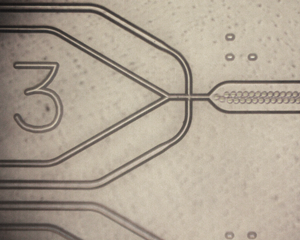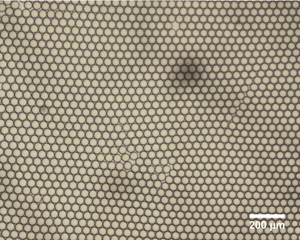Inside the Dolomite Labs: Polyacrylamide bead formation using FluoSurf
In anticipation of the new product launch of FluoSurf, our new fluorinated emulsion stabilizer, the Dolomite Team have been testing the product across a range of applications. This week, we have been synthesizing polyacrylamide beads. These beads are a type of hydrogel, consisting of a loosely cross-linked polyacrylamide structure that is capable of holding large amount of water. The beads can be readily surface functionalized, and are used in a wide range of applications including RNA capture, drug encapsulation and controlled release, and enzyme immobilization. In order to demonstrate the production of these materials at large scales, this work was carried out using a single-slice Telos® system.
Droplets containing the polyacrylamide precursors and a reaction initiator were pinched off at a microfluidic junction by a flow of FluoSurf, the highly effective stabilisation resulting in an output of monodisperse aqueous spheres 45 microns in diameter. As the chemical initiator kicks off the polymerisation reaction, the droplet begin to harden, and form stable hydrogel beads. Depending on the amount of crosslinker used, the firmness of the beads can be varied, depending on the end application of the material. These 45 ± 0.5 micron beads were made using a 50 μm Telos® 2 Reagent Chip, with a droplet production rate of 14 kHz. These specific conditions allow for the production of 2.5 g of monodisperse beads per hour, scaling to 25 g/hr with a full 10-slice Telos® System, with additional optimization of flow rates allowing for even larger production rates.
If you are interested in producing polyacrylamide beads for your applications, please contact us, and keep an eye out for our Polyacrylamide Bead application note, which we will be releasing onto the website in the near future.



